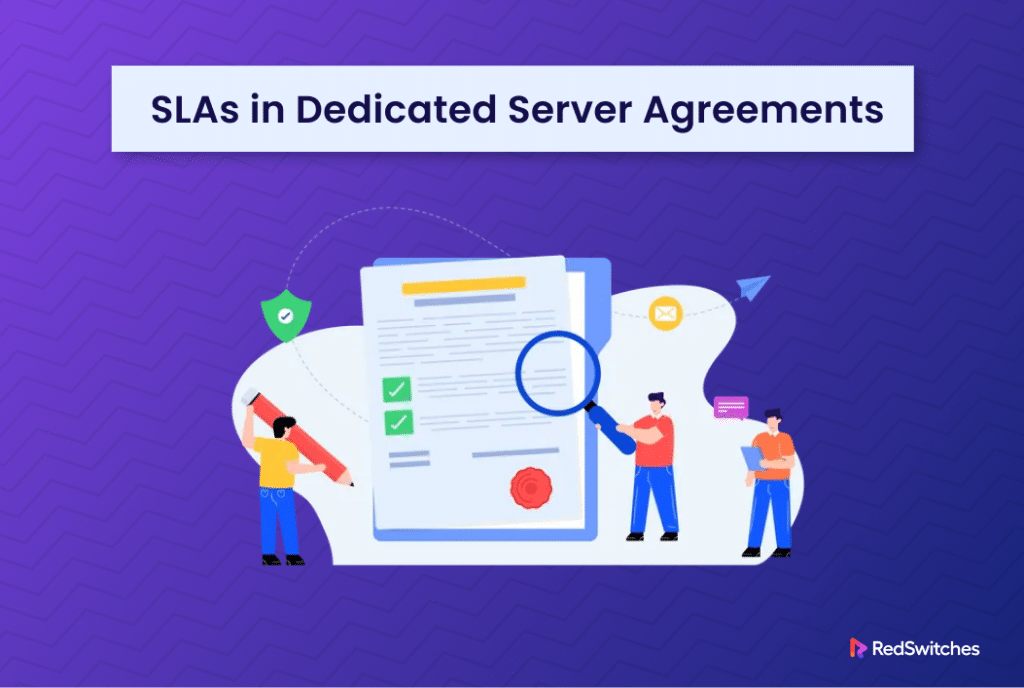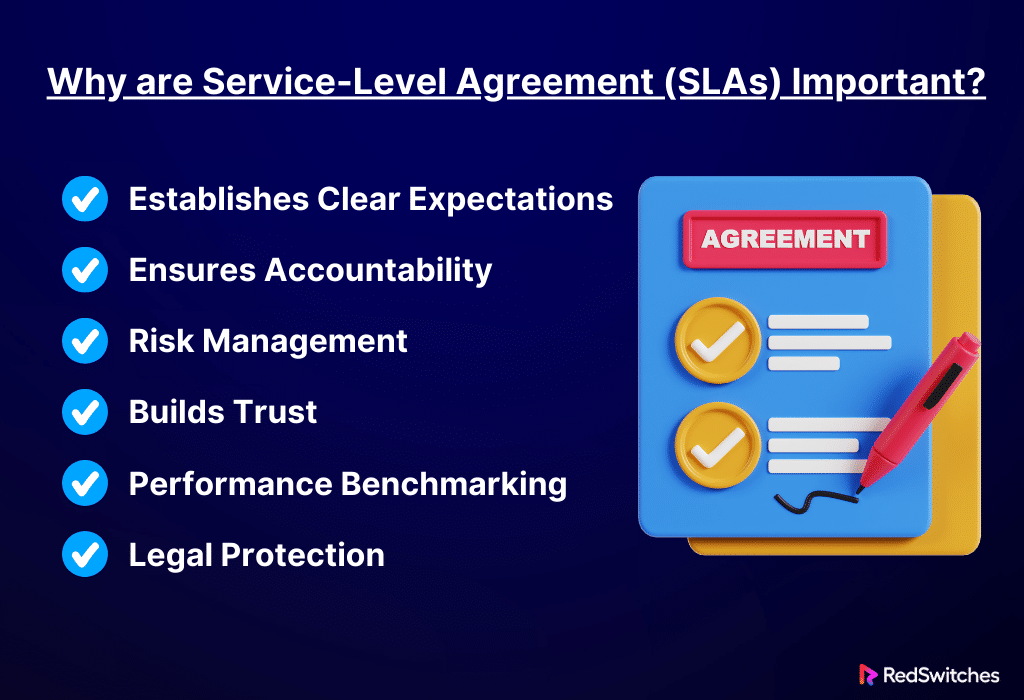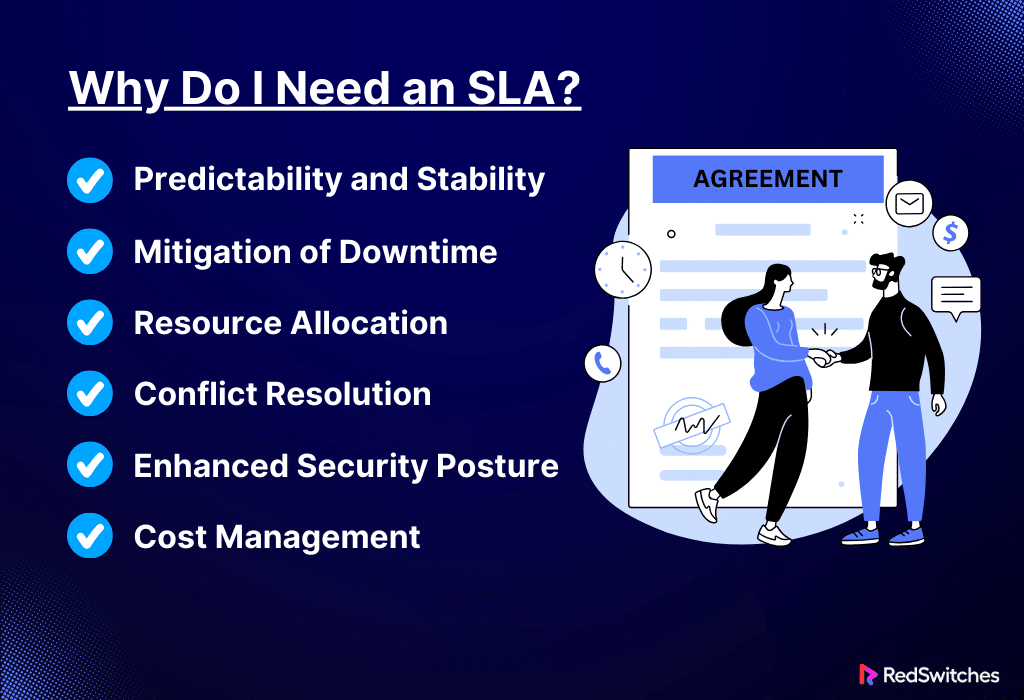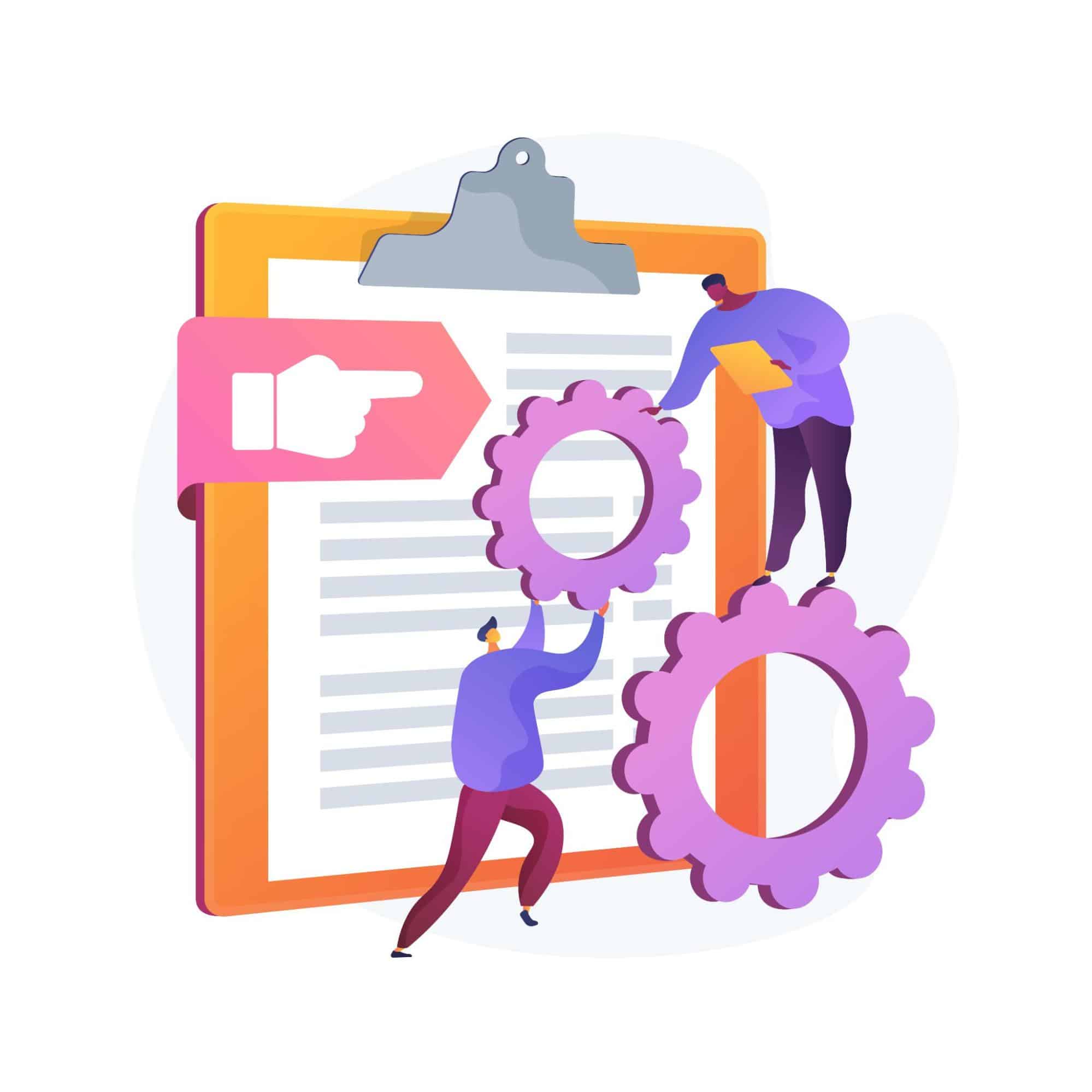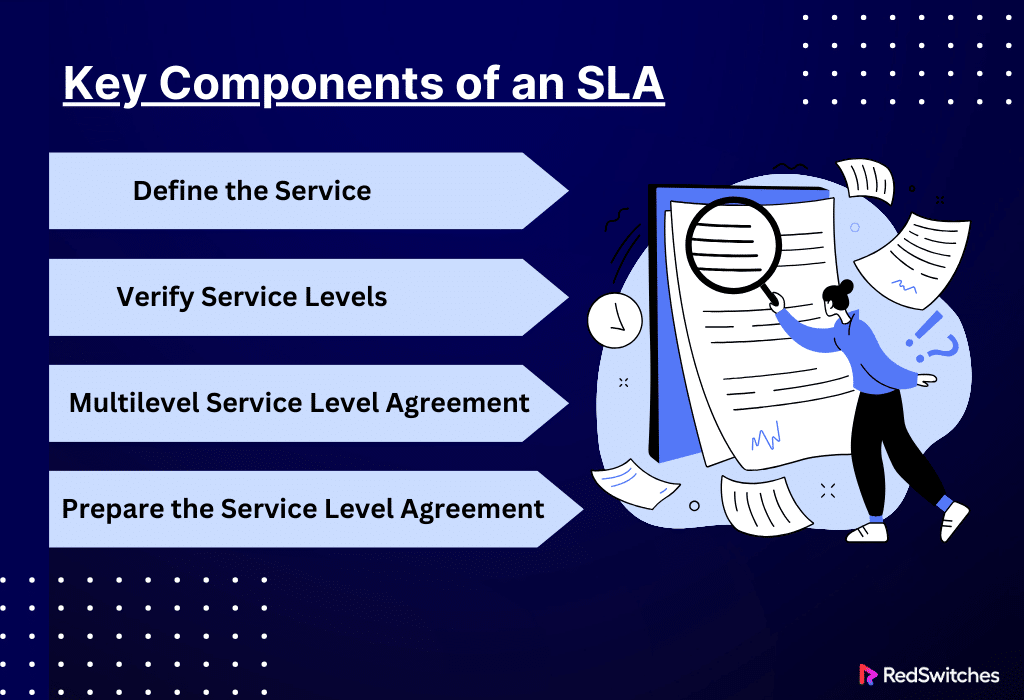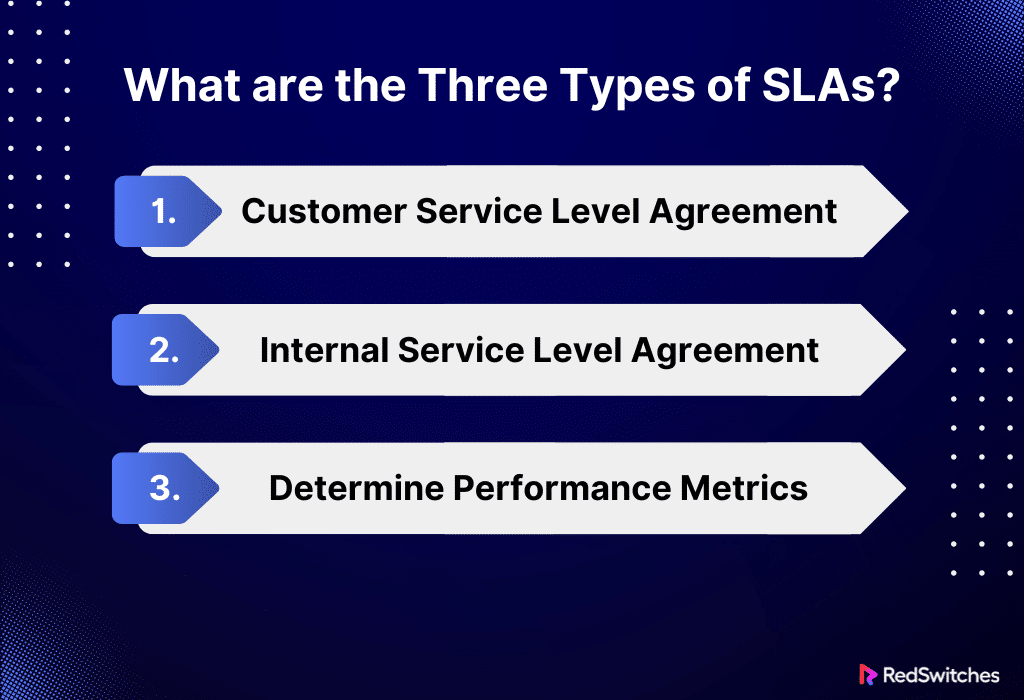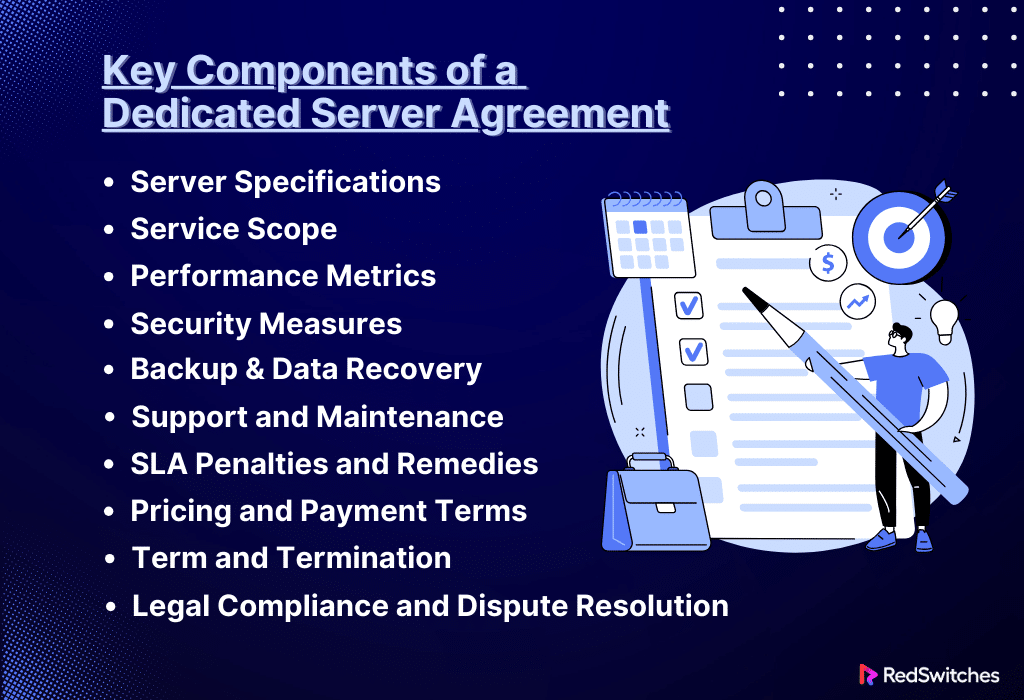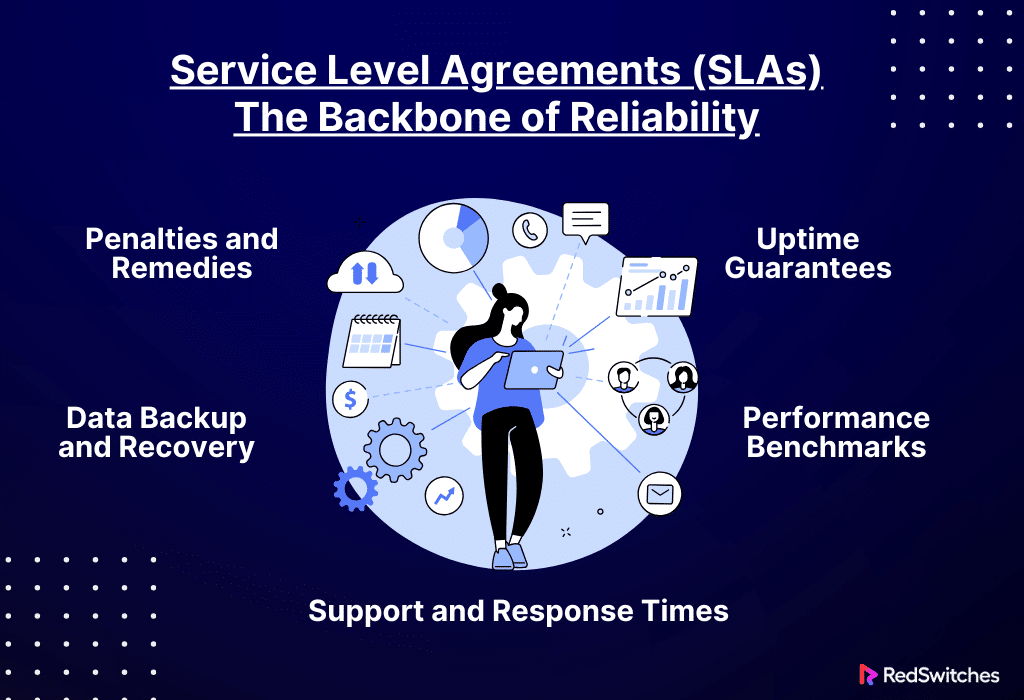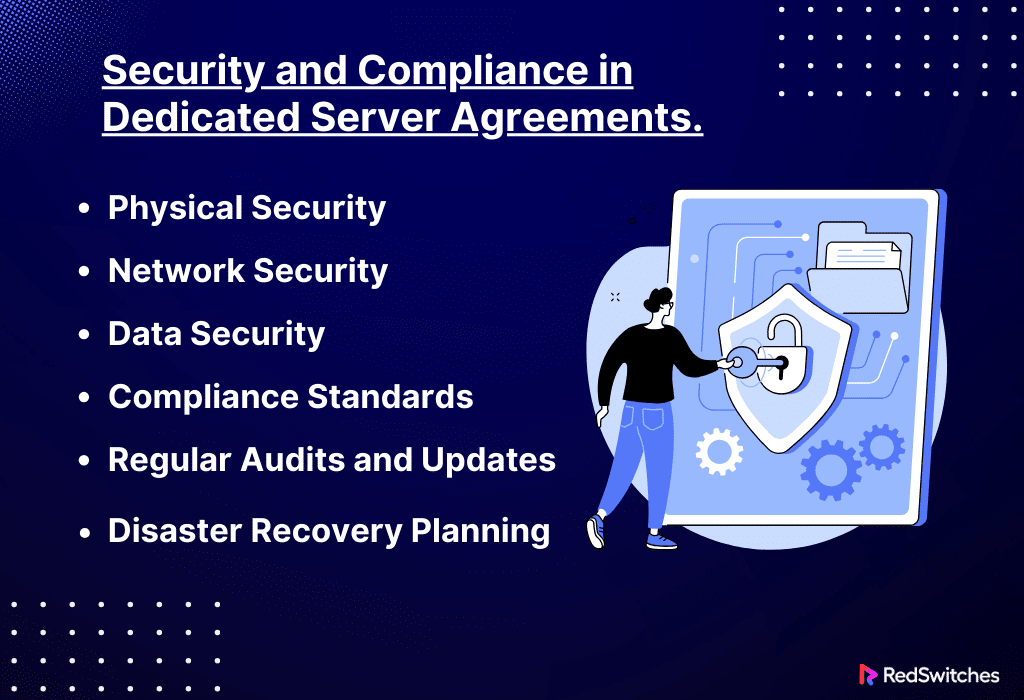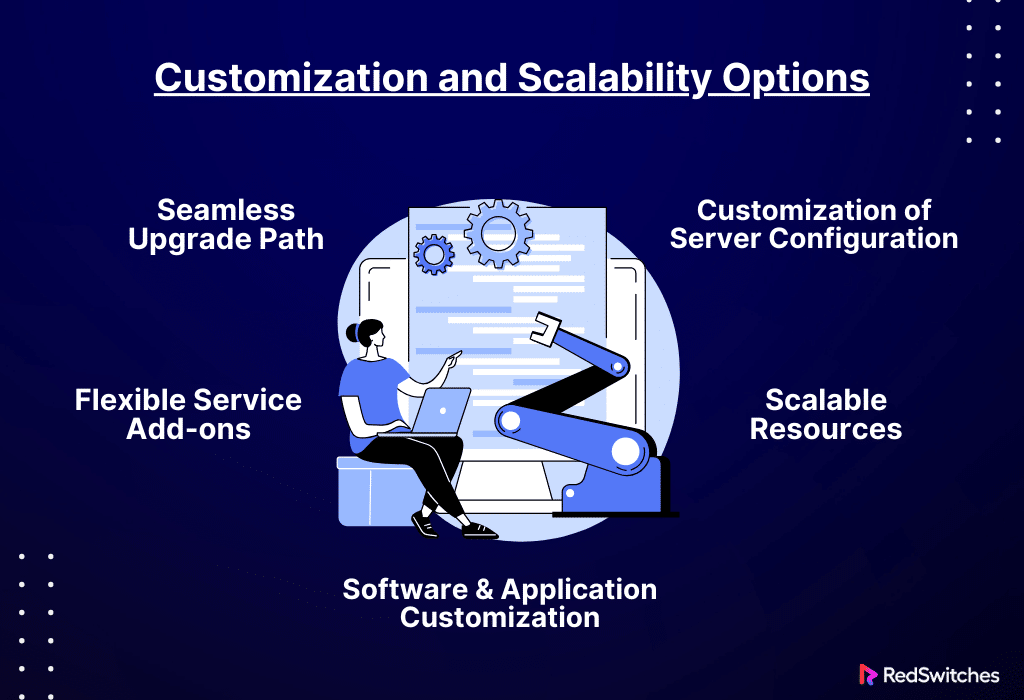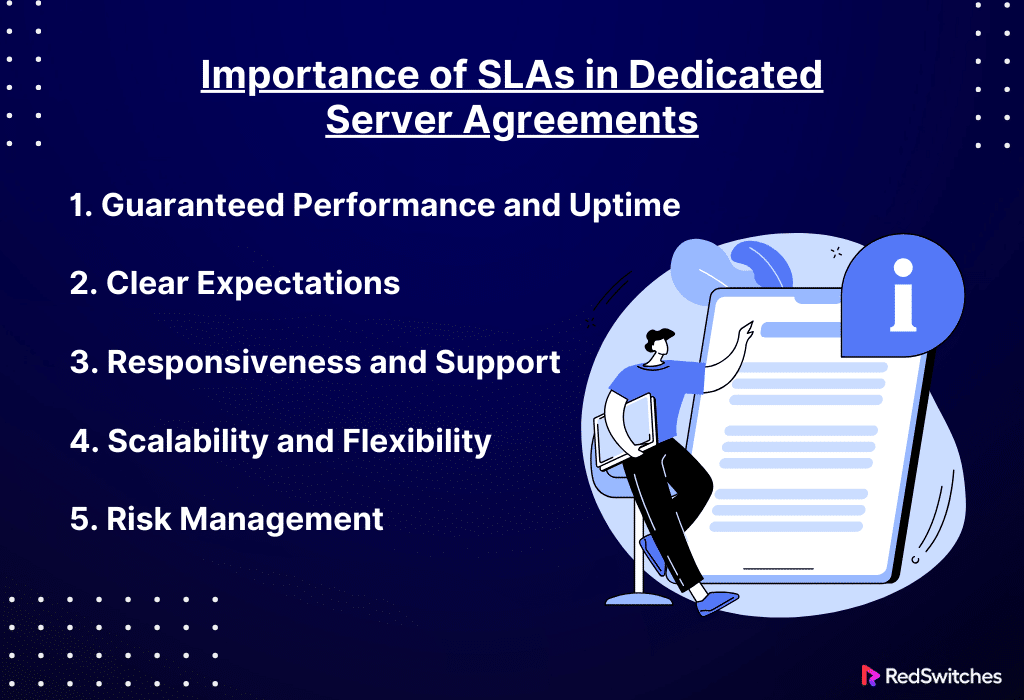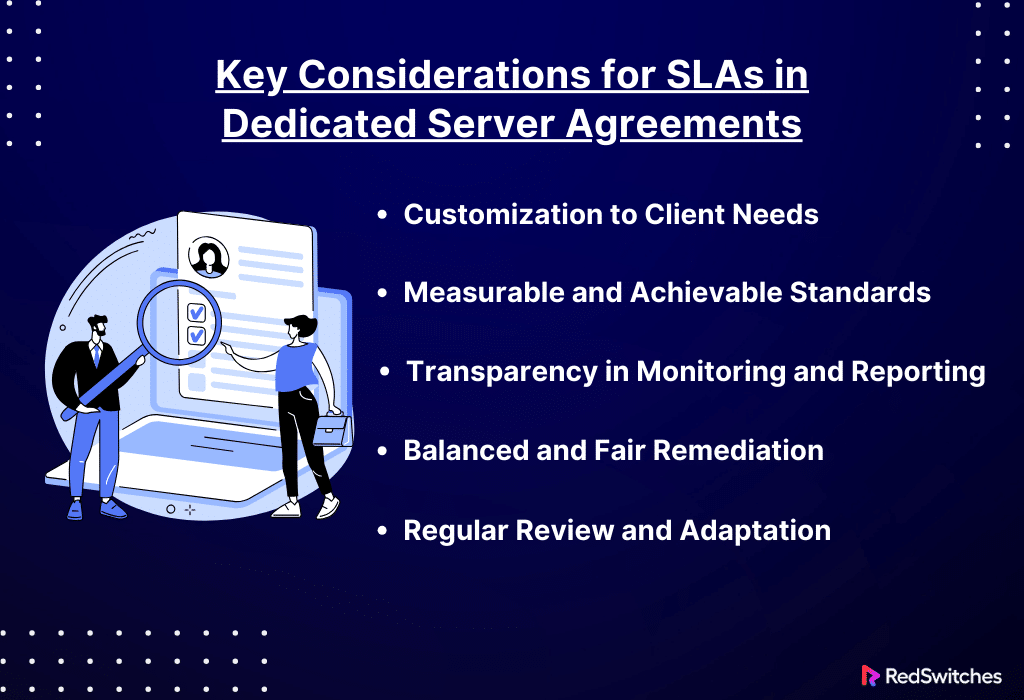Key Takeaways
- SLAs in dedicated server agreements establish precise service expectations and performance benchmarks.
- SLAs provide uptime guarantees, ensuring high availability and reliability of dedicated servers.
- Clearly defined SLA remedies hold service providers accountable for service lapses.
- Dedicated server agreements offer customization and scalability options to align with business growth.
- Security measures and compliance standards within agreements protect data and adhere to regulatory requirements.
- SLAs include provisions for transparent monitoring and reporting of service performance.
- SLA performance metrics encourage service providers to maintain high standards and proactive management.
- Choosing easily measured performance metrics ensures objective and accurate evaluation of services.
- Regular SLA reviews to ensure they remain relevant and meet changing business needs effectively.
- Understanding the renewal and cancellation policies in dedicated server agreements allows for informed decision-making and planning.
Understanding Service Level Agreements (SLAs) is very important for businesses and individuals. Whether you’re an IT expert, a business owner, or new to managing servers, this is true. It’s key to know about SLAs well.
SLAs are more than contracts. They build trust between you and your server provider. In this guide, we will simply explain SLAs. We will talk about what they mean for dedicated servers.
You’ll learn about different parts of SLAs. This includes uptime, keeping hardware running, and network connections. We are here to help you. You won’t just sign a paper. You’ll start a strong partnership. This guide will help you make intelligent choices. It will keep your online activities safe and make your digital setup strong.
Table of Contents
- Key Takeaways
- What is a Service-Level Agreement (SLA)?
- What are the Three Types of SLAs?
- Dedicated Server Agreements
- Service Level Agreements in Dedicated Server Agreements: SLA Best Practices
- SLA Performance Metrics
- Conclusion
- FAQs
What is a Service-Level Agreement (SLA)?
Credits: Freepik
A Service-Level Agreement (SLA) is a formal document defining the service level expected from a service provider. It’s a cornerstone in the relationship between a client and a service provider, particularly in dedicated servers.
SLAs detail the metrics by which service is measured and remedies or penalties should agreed-upon service levels not be achieved. Essentially, it’s a contract that ensures both parties understand service expectations, performance metrics, and accountability. Making it a vital tool for managing the relationship and ensuring quality service.
Also Read What Is Server Renting? An In-depth Look into Server Leasing
Why are SLAs Important?
SLAs are critical for several reasons:
- Establishes Clear Expectations:
SLAs clearly understand service parameters, minimizing ambiguities. And setting clear expectations for service delivery. - Ensures Accountability:
By defining specific metrics and remedies. SLAs ensure that the service provider is held accountable for maintaining the agreed-upon level of service. - Risk Management:
SLAs help identify and manage risks by outlining procedures for dealing with service failures or breaches. - Builds Trust:
A well-crafted SLA can build trust between the client and the service provider. It assures the client that the provider is committed to delivering high-quality service. - Performance Benchmarking:
SLAs offer a way to measure service performance against defined benchmarks, facilitating continuous improvement. - Legal Protection:
In disputes, SLAs serve as a legal document that can protect both parties’ interests.
SLAs are very important when it comes to dedicated servers. These servers need to work all the time without problems. SLAs are promises. They make sure your service is smooth, safe, and reliable. When we look closely at dedicated servers, SLAs become even more critical. They prove that your service is good and trustworthy.
Why Do I Need an SLA?
An SLA is not just a formal agreement. It’s a crucial component of your business’s operational backbone when dealing with dedicated servers. Here’s why having an SLA is essential:
- Predictability and Stability: SLAs help you know what to expect from your service. This lets you plan your business with confidence. Your server will meet specific standards.
- Mitigation of Downtime: They promise your server will be up and running most of the time. This cuts the risk of your server going down. That’s important because downtime can cost you money and harm your reputation.
- Resource Allocation: Knowing what your provider promises helps you plan better. You can make sure your IT setup meets your business needs.
- Conflict Resolution: If there’s a problem, SLAs tell you how to fix it. This saves time and makes sure both sides are treated fairly.
- Enhanced Security Posture: SLAs often encompass security standards and protocols. Ensuring your dedicated server is operational and secure against potential threats.
- Cost Management: SLAs enable more accurate budgeting and financial planning. This is done by clearly outlining service costs and penalties for service lapses.
Who Provides the SLA?
Credits: Freepik
SLAs are typically provided by the service provider offering the dedicated server services. These providers can range from specialized hosting companies to large-scale cloud service providers. The provider’s role is to:
- Draft the SL Create a comprehensive SLA that covers all aspects of the service being offered, tailored to meet the specific needs and concerns of the client.
- Ensure Compliance: Continuously monitor service performance to ensure compliance with the SLA terms. This involves implementing robust infrastructure, tools, and processes to measure and maintain service levels.
- Communicate Effectively: Maintain clear and open lines of communication with the client, ensuring that any issues or changes regarding the SLA are promptly addressed.
- Review and Update: Regularly review the SLA to ensure it remains relevant and effective, considering evolving business needs, technological advancements, and feedback from the client.
If you’re the client, it’s essential to read the SLA carefully. Make sure you understand it and that it meets your business needs. You should feel okay about asking to change parts of the SLA so it suits you better. And don’t hesitate to ask questions if something isn’t clear.
Also, Read The Difference Between Horizontal vs Vertical Scaling
Key Components of an SLA
Going through a Service Level Agreement (SLA) can seem complicated. There are many details and conditions. But knowing what’s in an SLA is key. It ensures the service you get fits your business’s needs and goals. This is especially true for dedicated servers.
An SLA is more than just promises. It’s a detailed plan. It shows the level of service you should get. Every part of the SLA ensures your server service is reliable, fast, and responds well to your needs.
1. Define the Service
The first and foremost component of an SLA is the clear definition of the service itself. This section is the foundation upon which the rest of the agreement is built, outlining what the client can expect from the service provider. This part must be articulated precisely to avoid any ambiguity leading to misunderstandings or disputes.
In the context of dedicated servers, the service definition would typically include:
- Server Specifications: Details about the server’s hardware components, such as CPU, RAM, storage type, and capacity.
- Network Performance: Information about network speed, bandwidth allocation, and data transfer limits.
- Uptime Guarantee: The percentage of time the server is expected to be operational and accessible.
- Maintenance and Support: Description of maintenance procedures, support availability, and the process for addressing technical issues.
- Security Measures: Details about the security protocols in place. Including data encryption, firewall protection, and intrusion detection systems.
- Backup and Data Retention: Data backup, disaster recovery, and data retention policies. This is to ensure data integrity and availability.
Having a well-defined service description ensures that both parties have a mutual understanding. This understanding is of what is being offered and what is expected, setting the stage for a successful partnership.
2. Verify Service Levels
Verifying service levels is about setting and agreeing upon specific, measurable service standards the provider is expected to meet. These standards, or performance metrics, are key to an SLA as they provide a quantifiable means to evaluate the service and ensure accountability. For dedicated server SLAs, standard service levels to verify and monitor include:
- Availability/Uptime: The percentage of time the server is operational and accessible. This is often expressed as a percentage, such as 99.9% uptime.
- Response Time: The time it takes for the provider to respond to a support request or technical issue.
- Resolution Time: The time it takes for the provider to resolve an issue or outage.
- Performance Metrics: Benchmarks for server performance, including processing speed, load times, and throughput.
Setting standards in an SLA is about ensuring there are ways to check and report on these standards. This can include using tools that monitor automatically, getting reports on how the service is doing, and getting instant alerts if the service isn’t meeting the agreed levels. When both the client and the provider keep an eye on the service quality and are ready to fix problems quickly, the service stays good and reliable.
Also read Server Disaster Recovery Plan: What to Include For Speedy Recovery
3. Multilevel Service Level Agreement
A Multilevel Service Level Agreement (SLA) is a detailed system. It organizes SLAs into different levels for complex service needs or many service types. For dedicated servers, a Multilevel SLA might have these parts:
- Corporate-Level SLA: This level covers the big picture. It’s the overall deal between the service provider and the client’s whole company. It includes the main rules, overall service standards, and policies for the whole company. It aims to give every department or business unit the same quality of service.
- Customer-Level SLA: This level is more personalized. It’s for specific groups or business units in the client’s company. Here, the service levels are customized for each group’s unique needs. This ensures the services match the particular ways each group operates and their goals.
- Service-Level SLA: This tier concerns specific services, like dedicated server hosting. It details technical stuff, how to measure performance, and who is responsible for what. This level is about ensuring the dedicated server’s quality and performance precisely fit the client’s needs.
A Multilevel SLA makes it clear and organized how to manage and provide services. It ensures that all client needs are met in a detailed and united way.
4. Prepare the Service Level Agreement Document
Making an SLA document is a key step. It makes the agreement official between the service provider and the client. A good SLA document is a legal contract and a guide for managing the service. Here’s how to make a strong SLA document for dedicated server services:
- Gather Information: Get all the needed details about the service. This includes the tech specs, how to measure performance, and what the client needs.
- Structure the Document: Make the SLA clear and organized. Divide it into sections like what the service includes, service levels, how to keep track and report, how to handle problems, and the rules and conditions. Make sure it’s easy to understand.
- Draft Clear Terms: Use clear and direct language. Describe the services, who’s responsible for what, and what’s expected. Make sure every term and condition is clear to prevent misunderstandings.
- Include Remedies and Penalties: Explain what happens if the service doesn’t meet the agreed levels. Ensure the compensation or fixes are fair and match the issue’s impact.
- Review and Revise: Work with all the important people, like legal teams, service managers, and the client. Look at the SLA together. Take in their feedback and make changes to make sure the document shows what everyone agreed on.
- Obtain Approvals: When the SLA is ready and perfect, get an official okay from everyone involved. Make sure everyone understands and agrees to what’s in the document.
- Distribute and Store Securely: Give the final SLA document to everyone who should have it. Keep it in a safe place where you can get to it for checking, keeping track, and looking at it later on.
A carefully made SLA document makes the service deal solid. It’s a basic tool for delivering the service well and keeping a good relationship with the client.
Also Read 5 Best Practices to Manage your Cloud Computing Resources
What is an Indemnification Clause?
Credits: Freepik
An indemnification clause is a legal part often found in Service Level Agreements (SLAs) and other contracts. It protects one side from paying for losses or being held responsible for specific actions or situations. It’s a way to manage risks. It ensures that if one side has to pay for something specific, the other side will cover the costs or compensate for the damage.
In dedicated server SLAs, an indemnification clause might take care of things like:
- Data Breaches:
If there’s a security problem because the service provider didn’t do their part, this clause ensures the provider pays for the costs. This can include legal fees, letting people know about the breach, and helping those affected to keep an eye on their credit. - Intellectual Property Violations:
This clause protects the client if the service uses something that belongs to someone else without permission. It covers the legal troubles and costs of this kind of problem. - Non-compliance with Laws:
This clause protects the client from fines or legal issues if the service provider doesn’t follow specific rules or laws.
Both sides need to read and understand the indemnification clause well. This makes sure everyone is protected fairly from possible risks and responsibilities.
Review the SLA with All Stakeholders
Credits: Freepik
Bringing together key people is crucial when looking at a Service Level Agreement (SLA). You should include IT, legal, finance, and management team members. These people can be from both the client’s and the service provider’s sides.
Here’s what to do in a review:
- Talk About the SLA Terms: Go through the SLA, part by part. Talk about what each service includes, how you’ll measure performance, who’s in charge of what, and any legal parts. This includes indemnification clauses and responsibility limits.
- Handle Concerns and Questions: Let everyone bring up any worries or questions about the SLA. This is the time to clear up anything that’s not clear. Make sure everyone understands the agreement the same way.
- Get Advice from Lawyers: Have legal experts look at the legal parts of the SLA. This includes indemnification clauses. They’ll make sure the agreement is legally solid and protects both sides.
- Write Down Feedback and Changes: Note any feedback, worries, or changes during the review. If needed, change the SLA document. Then, give out the new version for more review.
- Get the Final OK: When everyone agrees to the SLA terms, get a formal okay and signatures from people who can sign.
Checking the SLA with everyone involved makes things clear and in agreement. It lowers the chance of problems later and helps ensure the partnership works well.
Also Read 6 Top Cloud Infrastructure Benefits For Your Business
What is an Earn Back?
Credits: Freepik
An “earn back” is a special part of Service Level Agreements (SLAs). It lets a service provider make up for some of the fines they got for not meeting service levels. It’s like a motivator for the provider to keep up good service and improve.
For dedicated servers, if a provider doesn’t hit the promised service levels. Like how often the server is up or how fast they respond, and they have to pay fines, they might be able to get some of those fines back. They can do this if they:
- Hit or Go Beyond Goals: Show that their service is consistently as good as or better than what was promised.
- Make Things Better: Fix the main issues that caused the problem in the first place. Make changes that make the overall service better.
- Keep Up the Good Work: Improve service levels for a set time. This shows they are serious and reliable.
The specific rules of an “earn back” clause, like how much of the fines can be earned back. What the service provider needs to do and the time they have to do it should be clearly laid out and agreed on by everyone in the SLA.
What are the Three Types of SLAs?
Service Level Agreements (SLAs) are fundamental to managing and measuring service delivery. They vary based on the nature of the relationship between the service provider and the recipient. Generally, SLAs can be classified into three primary types: Customer, Internal, and Multilevel. Each type caters to different aspects of service management and serves distinct purposes within an organization’s operational framework.
1. Customer Service Level Agreement
A Customer Service Level Agreement focuses on the service relationship between the provider and an external customer. This type of SLA is outward-facing and is designed to meet the specific needs of individual customers or customer groups. In the realm of dedicated servers, a Customer SLA would detail the specifics of the server hosting services provided, including
- Server Uptime Guarantees: The promised server availability.
- Technical Support: The scope and responsiveness of support services.
- Security Protocols: Measures in place to protect the server and its data.
- Backup and Recovery Procedures: How data is protected against loss and can be restored in case of a failure.
Customer SLAs are crucial for establishing trust and ensuring customer satisfaction. They provide transparency and set clear expectations for the service being provided.
2. Internal Service Level Agreement
An Internal Service Level Agreement is an agreement between one internal group and another within the organization. They define the quality and the timeline of services provided internally, such as between an IT department and a business unit within the same company. An internal SLA might cover dedicated server management:
- IT Support Response Times: How quickly the internal IT team commits to addressing an issue.
- Maintenance Windows: Scheduled times for server updates or repairs, ensuring minimal disruption to internal users.
- Internal Reporting Requirements: Regular reporting on server performance, security, and other critical metrics.
Internal SLAs are instrumental in aligning the goals of various internal teams and ensuring that internal service providers effectively meet their internal customers’ needs.
3. Determine Performance Metrics
Determining performance metrics is integral to crafting any SLA. These metrics provide a clear, quantifiable measure of the service quality and are used to evaluate whether the service provider is meeting the commitments made in the SLA. For dedicated server SLAs, performance metrics might include:
- Availability/Uptime: The percentage of time the server is functioning and accessible.
- Latency: The time it takes for the server to respond to a request.
- Bandwidth: The amount of data that can be transferred in a given period.
- Security Incidents: The number of breaches or security incidents within a given timeframe.
Performance metrics should be realistic, measurable, and aligned with business objectives. They are essential for maintaining transparency between the service provider and the client and ensuring that the service meets the agreed-upon standards.
Understanding the different types of SLAs and the importance of performance metrics is vital for managing the quality of service delivery and ensuring that the services provided align with the needs and goals of both providers and clients.
Also Read What is Provisioning in Cloud Computing? 7 Key Areas To Consider
Dedicated Server Agreements
Credits: Freepik
Dedicated server agreements are essential contracts. They outline the details, rules, and what both sides expect when providing dedicated server services. These agreements are essential. They ensure that the service provider and the client have the same understanding. They ensure that the server’s performance, safety, and dependability match the client’s business needs. A good dedicated server agreement includes many important parts. Each part has a specific role in ensuring the service is delivered and managed properly.
Key Components of a Dedicated Server Agreement
Dedicated server agreements are detailed contracts. They cover everything about providing dedicated server services. These agreements are crucial for a clear understanding between the service provider and the client. They ensure the server’s work, safety, and reliability suit the client’s business needs. A well-made agreement includes these key parts:
- Server Specifications: Lists the server’s physical and tech details. This includes the CPU’s type and speed, the RAM’s size, how much storage and what type (HDD or SSD), bandwidth, and any other hardware or network details.
- Service Scope: Defines the services offered. This can include setting up the server, looking after the hardware, installing and updating software, managing the network, security steps, and any extra services.
- Performance Metrics: Sets clear, measurable standards for how the server should work. This covers how often the server is up, how much bandwidth is available, how fast data moves, and how quickly support responds to problems.
- Security Measures: Describes how the server and its data are protected. This includes firewalls, how data is encrypted, systems to spot intrusions, and regular checks for security.
- Backup and Data Recovery: Explains how data is backed up, plans for recovering after disasters, and how to get data back if there’s hardware failure or other serious issues.
- Support and Maintenance: Outlines what tech support is offered. This includes when support is available, how quickly they respond, and when they do maintenance to cause the least disruption.
- SLA Penalties and Remedies: Explains what happens if the service doesn’t meet the agreed levels. This ensures responsibility and fair compensation if the service isn’t up to standard.
- Pricing and Payment Terms: Details of how much the services cost, when payments should be made, and any other financial details. This could include fines for late payments or discounts for signing up for a long time.
- Term and Termination: Says how long the agreement lasts, how and when it can be renewed or ended, and what both sides need to do if it ends.
- Legal Compliance and Dispute Resolution: Discuss following laws and regulations and resolving disagreements. This includes which laws apply and what legal steps can be taken.
A complete dedicated server agreement makes the relationship between the service provider and the client clear, effective, and good for both sides. It’s the basis for trust, reliability, and top-quality service. It helps businesses make the most of their dedicated server.
Service Level Agreements (SLAs): The Backbone of Reliability
Service Level Agreements (SLAs) are essential for ensuring trust in dedicated server agreements. They are key documents that confirm the service provider’s promise to meet certain service levels. They also protect the client by setting clear, measurable service delivery standards. In dedicated servers, SLAs are very important. They directly affect how well the client’s operations run. This, in turn, impacts the client’s business reputation and success. The main parts of SLAs in dedicated server agreements often include
- Uptime Guarantees: SLAs usually promise that the server will be up and running for a certain amount of time. This is often shown as 99.9% or more.
- Performance Benchmarks: These are set standards for how well the server should work. This includes how fast it responds, how quickly it processes things, and how well it manages different amounts of work. This makes sure the server meets what the client needs for their operations.
- Support and Response Times: SLAs tell how quickly the service provider needs to answer and fix any problems or questions. This ensures the client gets help fast and their services aren’t interrupted too much.
- Data Backup and Recovery: SLAs explain what the provider has to do about backing up data, where the backups are kept, and how to get the data back. This makes sure the data is safe and can be reached.
- Penalties and Remedies: SLAs lay out what happens if the service provider doesn’t meet the agreed-upon service levels. This gives the client protection and peace of mind.
By making these points clear, SLAs build a base of trust and reliability. They ensure that dedicated servers are not just a tech resource, but a dependable part of the client’s business.
Also Read Unleash Your Business Potential: How to Get a Server on Rent
Security and Compliance in Dedicated Server Agreements.
Security and compliance are paramount in dedicated server agreements, given the critical nature of the data and applications they host. A comprehensive dedicated server agreement addresses these concerns by integrating robust security measures and ensuring adherence to legal and regulatory standards. Key considerations include:
- Physical Security: Ensures the physical protection of the server infrastructure. Including secure data center facilities, controlled access, and surveillance systems.
- Network Security: Involves the implementation of firewalls and intrusion detection systems. And regular network monitoring to protect against unauthorized access and cyber threats.
- Data Security: Includes encryption standards for data at rest and in transit. Plus, secure data backup solutions and data privacy policies to protect sensitive information.
- Compliance Standards: Addresses the need to comply with industry-specific regulations and standards, such as GDPR for data protection, HIPAA for healthcare information, or PCI DSS for payment data.
- Regular Audits and Updates: Involves conducting regular security audits, vulnerability assessments, and timely updates of security protocols to address emerging threats and vulnerabilities.
- Disaster Recovery Planning: Outlines the procedures for data recovery and system restoration in case of a security breach, hardware failure, or natural disaster, ensuring business continuity.
Credits: Freepik
By prioritizing security and compliance, dedicated server agreements protect the integrity and confidentiality of the client’s data and reinforce their reputation and trustworthiness as a business entity committed to maintaining the highest data protection standards and regulatory compliance.
Customization and Scalability Options
Customization and scalability are crucial in dedicated server agreements. They ensure the server setup fits the client’s current needs and can change as those needs grow. A flexible SLA helps businesses grow smoothly and keeps their IT resources aligned with their expansion. Things to focus on include:
- Customization of Server Configuration: This lets clients pick specific hardware setups. They can choose the CPU type, how much RAM, how much storage, and the network speed. This is all to match their unique needs for performance and applications.
- Scalable Resources: Clients can adjust their server resources as needed. They can add more during busy times and reduce them when quieter. This helps them have enough resources when it’s busy and saves money when it’s not.
- Software and Application Customization: Clients can set up and adjust specific software, applications, and operating systems. This makes sure their server supports their business operations just right.
- Flexible Service Add-ons: Clients can add extra services when they need them. This could be better security, advanced monitoring tools, or support options. This lets clients enhance their server as their needs change.
- Seamless Upgrade Path: This ensures clients can improve their server setup easily and without much interruption. This is important for handling more data, users, and complex applications as the business grows.
By adding options for customization and scalability in dedicated server agreements, service providers can give solutions that can adapt and focus on the client. This helps businesses manage their growth effectively and stay ahead in the online world.
Navigating the Renewal and Cancellation Policies
Renewal and cancellation policies are crucial in dedicated server agreements. Outlining the terms under which clients can continue or terminate their services. Clear and fair policies ensure a transparent relationship between the service provider and the client. Fostering trust and long-term partnership. Essential aspects to consider include
- Renewal Terms: Clearly outline how and when the services can be renewed. This includes any changes in pricing, service levels, or terms that might come with renewal.
- Cancellation Notice Period: Clearly state how much advance notice is needed to cancel the service. This ensures both sides have enough time to prepare and adjust their plans.
- Early Termination Fees: If it’s part of the agreement, detail any fees or penalties for ending the agreement early. Make sure these fees are fair and match the length of the service and the investment made.
- Data Retention and Migration: Describe the steps for keeping, getting, and moving data if the service is canceled. This ensures the client’s data stays safe and can be accessed even after the service ends.
- Post-Termination Responsibilities: Define what each side needs to do after the service ends. This includes returning any equipment, settling any final bills, and how to handle private information.
By carefully handling renewal and cancellation terms, clients can make smart decisions about their dedicated server services. This helps them keep their business plans flexible and ready for the future. Service providers, in return, can show they are committed to being open and focused on client satisfaction. This strengthens a strong and lasting business relationship.
Also Read Backup Disaster Recovery Solutions: What’s The Better Investment?
Service Level Agreements in Dedicated Server Agreements: SLA Best Practices
Credits: Freepik
Service Level Agreements (SLAs) within dedicated server agreements are pivotal in defining, measuring, and ensuring the quality and reliability of hosting services. These SLAs serve as a formal commitment by the service provider to meet specified service standards, offering clients peace of mind and a clear framework for accountability. In dedicated server agreements, SLAs are not just ancillary components but integral elements that can significantly impact the effectiveness and efficiency of a client’s operations.
Importance of SLAs in Dedicated Server Agreements
- Guaranteed Performance and Uptime: SLAs layout performance targets like server uptime. This ensures the servers continuously work as promised, cutting downtime and related costs.
- Clear Expectations: SLAs state service details, setting exact expectations for both sides. This reduces confusion and prevents possible disagreements.
- Responsiveness and Support: SLAs set standards for how quickly support responds and solves issues. This ensures problems are handled quickly and well.
- Scalability and Flexibility: SLAs can include terms for scaling services. This ensures server resources can change to meet the evolving needs of the client’s business.
- Risk Management: SLAs have penalty clauses and steps for fixing issues. This protects clients from the risks of service problems, offering compensation or solutions if service levels aren’t met.
Key Considerations for SLAs in Dedicated Server Agreements
- Customization to Client Needs: SLAs should be customized for the client’s specific needs and goals. This ensures the service levels are relevant and match the client’s operational needs.
- Measurable and Achievable Standards: SLA performance metrics should be clear, realistic, and possible. This allows for precise measurement of service quality and the provider’s performance.
- Transparency in Monitoring and Reporting: SLAs should include ways to check service performance and report clearly to the client regularly. This ensures ongoing adherence to the agreed service levels.
- Balanced and Fair Remediation: The steps and penalties for fixing SLA issues should be fair and match the impact of the service problem. This offers proper compensation to the client and motivates continuous service improvement.
- Regular Review and Adaptation: SLAs should be reviewed and updated regularly. This reflects new technology, changes in client needs, and lessons from delivering the service. This makes sure the agreement stays relevant and effective.
In summary, SLAs in dedicated server agreements are vital for a trustworthy, high-performing, and responsive hosting service. They create a clear and trusting relationship between the service provider and the client, forming the basis for a successful and beneficial partnership for both sides.
Also Read Server Racks and Server Rack Cabinets: Ultimate 2024 Guide
SLA Performance Metrics
Performance metrics in Service Level Agreements (SLAs) are essential. They are quantifiable standards that service providers must meet as part of the agreement. Specifically in dedicated server agreements. These metrics are crucial in ensuring the server’s performance aligns with the client’s expectations and needs for their operations. Effective SLA performance metrics promote the right actions from the service provider. They are selected for their relevance and how easy they are to measure.
Facilitate the Right Behaviour
SLA performance metrics guide service providers to follow best practices and maintain high service standards. To encourage the right behavior:
- Align with Business Objectives:
The metrics should directly match the client’s business goals. This ensures that the server’s performance positively influences the client’s operations.
- Encourage Proactive Management:
The metrics should push the service provider to monitor and manage the server infrastructure actively. This helps to stop problems before they can affect the client.
- Promote Continuous Improvement:
The metrics should motivate the service provider to keep improving their processes and technology. This enhances the overall quality of the service.
- Ensure Accountability:
Clear and transparent metrics ensure the service provider is responsible for their performance. There are set outcomes if they don’t meet the standards.
Choose Metrics that are Easily Measured
Selecting easily and accurately measured metrics is essential for effectively enforcing and managing SLAs. To ensure that metrics are measurable:
- Use Quantifiable Data:
Metrics should be based on quantifiable data that can be objectively measured, such as uptime percentages, response times, and bandwidth usage.
- Implement Reliable Monitoring Tools:
Utilize robust monitoring tools to accurately track and report performance metrics, providing the client and the service provider with reliable data.
- Define Clear Measurement Methods:
Clearly define how and when the metrics will be measured, ensuring that both parties understand the measurement process.
- Regularly Review and Validate:
Regularly review the measurement methods and results to validate their accuracy, making adjustments as necessary to ensure the data reflects the proper performance of the service.
By choosing easily measured metrics and aligning them with the desired behavior. SLAs in dedicated server agreements become potent tools for ensuring service quality, reliability, and alignment with the client’s business needs. They provide a clear and objective basis for evaluating the service provider’s performance and fostering a transparent and accountable service relationship.
Conclusion
Navigating through dedicated server agreements and SLAs reveals their true importance. They are more than just formal agreements; they are the foundations of a strong, dependable, and secure hosting service. These documents guarantee openness, responsibility, and high performance. They align precisely with your business’s needs for operations and growth. Recognizing and using these agreements is crucial, whether it’s about expanding your business, securing your data, or demanding consistent reliability.
Are you prepared to step into the highest level of dedicated server solutions? Are you seeking a provider prioritizing transparency, performance, and customer satisfaction?
RedSwitches offers dedicated server solutions tailored to your unique business needs. Our commitment to excellence is not just a promise; it’s embedded in every SLA and every server we manage.
Embark on a journey towards impeccable service and unwavering reliability with RedSwitches today. Your dedicated server solution, backed by our iron-clad SLAs, awaits you.
FAQs
Q. What are the 3 types of SLA?
There are mainly three types of SL Service-based SLA, Customer-based SLA, and Multi-level SLA.
Q. What is the purpose of the SLA?
An SLA is an agreement overview that sets the terms and conditions for providing a specific service by a service provider, establishing the obligations and expectations of both parties.
Q. What are the key elements included in an SLA template?
An SLA template typically includes details about the type of service to be provided, service metrics, service availability, service credits, and the responsibilities of both parties.
Q. What is an example of an SLA?
Examples of SLAs include those for IT service desk support, cloud service availability, network uptime, and customer support response times.
Q. What metrics should be included in an SLA?
An SLA should include metrics such as service availability, response and resolution times, and any other relevant performance indicators specific to the service being provided.
Q. How do you design an SLA?
To design an SLA, the service provider may need to collaborate with the customer to understand the expected service levels and then create an agreement that meets those requirements.
Q. What is the significance of service level management about SLAs?
Service level management is crucial in ensuring that the agreed service levels are consistently met, and it involves monitoring, reporting, and managing the performance of services to adhere to the SLA.
Q. What is a Service Level Agreement (SLA)?
An SLA is a contract between a service provider and a customer that outlines the level of service to be expected. It may include service details, the metrics by which it will be measured, and the remedies or penalties if the agreed-upon service levels are not achieved.
Q. What are the common metrics included in SLAs?
Common SLA metrics include response time, resolution time, uptime percentage, and other performance indicators specific to the type of service being provided.
Q. How do I create an SLA for a specific service?
To create an SLA, you must identify the service or services to be covered. Determine the metrics to be included and establish the expected level of service for each metric.
Q. Can a single service provider have multiple SLAs for different services?
Yes, a single service provider can have multiple SLAs. Each is tailored to a specific service or group of services they offer.
Q. What is an external service agreement in the context of SLAs?
An external service agreement, also called an external SLA, is a service-level agreement between a service provider and a client who is not an employee of the provider, such as an external customer or another organization.
Q. Can there be different levels of service within an SLA?
Yes, a multi-level SLA is an agreement that includes different service levels for different aspects of the service. Allowing for variations in service quality based on specific needs or circumstances.
Q. How does the success of the service impact an SLA?
The service’s success is measured against the criteria detailed in the SLA. The SLA is successful if the service provider meets or exceeds the defined service levels. Failure to meet the agreed-upon service levels may result in penalties or other consequences outlined in the SLA.
